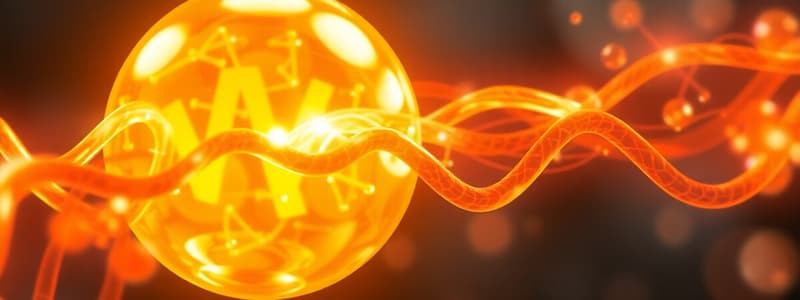Podcast
Questions and Answers
What is the primary role of high-energy phosphates in biological work?
What is the primary role of high-energy phosphates in biological work?
- To buffer lactic acid production
- To provide energy for cellular processes (correct)
- To facilitate the breakdown of fatty acids
- To store excess glucose
During a sprint lasting less than 10 seconds, which energy system is predominantly utilized?
During a sprint lasting less than 10 seconds, which energy system is predominantly utilized?
- ATP-PCr system (correct)
- Glycolytic system
- Aerobic system
- Beta-oxidation
Which of the following is a major function of carbohydrates in energy metabolism?
Which of the following is a major function of carbohydrates in energy metabolism?
- Serving as the main fuel source for high-intensity exercise (correct)
- Providing building blocks for protein synthesis
- Facilitating the transport of oxygen in the blood
- Acting as a primary component of cell membranes
How does increased exercise intensity affect lactate formation and accumulation?
How does increased exercise intensity affect lactate formation and accumulation?
What is the principal role of the citric acid cycle in energy metabolism?
What is the principal role of the citric acid cycle in energy metabolism?
Which of the following describes a general pathway for energy release during macronutrient catabolism?
Which of the following describes a general pathway for energy release during macronutrient catabolism?
How does ATP yield from the catabolism of a molecule of carbohydrate compare to that of a molecule of lipid?
How does ATP yield from the catabolism of a molecule of carbohydrate compare to that of a molecule of lipid?
Which metabolic process allows for interconversions among carbohydrate, lipid, and protein?
Which metabolic process allows for interconversions among carbohydrate, lipid, and protein?
What two contributions do high-energy phosphates provide for powering biological work?
What two contributions do high-energy phosphates provide for powering biological work?
What are the three stages that lead to the release and energy conservation by cells for biological work?
What are the three stages that lead to the release and energy conservation by cells for biological work?
Which feature of ATP allows it to serve as the 'energy currency' of the cell?
Which feature of ATP allows it to serve as the 'energy currency' of the cell?
How does phosphocreatine (PCr) facilitate ATP resynthesis during intense exercise?
How does phosphocreatine (PCr) facilitate ATP resynthesis during intense exercise?
Why is the anaerobic energy system important during high-intensity exercise?
Why is the anaerobic energy system important during high-intensity exercise?
Three factors regulate glycolysis; which of the options listed is NOT one of them?
Three factors regulate glycolysis; which of the options listed is NOT one of them?
What role does hormone-sensitive lipase play in fat mobilization?
What role does hormone-sensitive lipase play in fat mobilization?
What is the function of the citric acid cycle in the context of the metabolic mill?
What is the function of the citric acid cycle in the context of the metabolic mill?
How does a high-carbohydrate diet affect protein utilization during exercise?
How does a high-carbohydrate diet affect protein utilization during exercise?
Under what conditions would protein become a more significant energy source during exercise?
Under what conditions would protein become a more significant energy source during exercise?
How does the location of ATP production differ between glycolysis and the citric acid cycle?
How does the location of ATP production differ between glycolysis and the citric acid cycle?
How does exercise affect hormonal release and its subsequent effect on fat mobilization?
How does exercise affect hormonal release and its subsequent effect on fat mobilization?
In anaerobic glycolysis, what is the end product of glucose breakdown, and what happens to it?
In anaerobic glycolysis, what is the end product of glucose breakdown, and what happens to it?
Which energy substrate provides the most ATP molecules upon complete oxidation?
Which energy substrate provides the most ATP molecules upon complete oxidation?
What is the primary function of carbohydrate in energy metabolism?
What is the primary function of carbohydrate in energy metabolism?
What is the primary fate of pyruvate during anaerobic glycolysis?
What is the primary fate of pyruvate during anaerobic glycolysis?
What conditions need to be met to operate at steady-rate during physical activity?
What conditions need to be met to operate at steady-rate during physical activity?
How do scientists define maximal oxygen consumption, or VO2max?
How do scientists define maximal oxygen consumption, or VO2max?
What term describes bodily processes that do not immediately return to resting levels after physical activity?
What term describes bodily processes that do not immediately return to resting levels after physical activity?
What characterizes blood lactate accumulation during exercise?
What characterizes blood lactate accumulation during exercise?
Why do endurance-trained individuals have a higher percentage of what they can sustain comfortably, in steady-state?
Why do endurance-trained individuals have a higher percentage of what they can sustain comfortably, in steady-state?
How is the energy for exercise created?
How is the energy for exercise created?
What facilitates aerobic metabolism for athletes?
What facilitates aerobic metabolism for athletes?
Why might a doctor recommend moderate intensity, 'active recovery' ?
Why might a doctor recommend moderate intensity, 'active recovery' ?
Why should athletes maintain appropriate stores of glycogen?
Why should athletes maintain appropriate stores of glycogen?
Which of the following is NOT part of what steady-rate exercise replenishes?
Which of the following is NOT part of what steady-rate exercise replenishes?
Why might blood lactate accumulate?
Why might blood lactate accumulate?
What is the relationship between energy consumption, rest, and exercise?
What is the relationship between energy consumption, rest, and exercise?
If not enough glycogen is present, will athletes be able to perform at their peak?
If not enough glycogen is present, will athletes be able to perform at their peak?
Why does the body primarily rely on phosphocreatine (PCr) for ATP resynthesis during short bursts of maximal activity?
Why does the body primarily rely on phosphocreatine (PCr) for ATP resynthesis during short bursts of maximal activity?
During intense exercise, why would an athlete's pyruvate predominantly convert to lactate instead of entering the aerobic pathways?
During intense exercise, why would an athlete's pyruvate predominantly convert to lactate instead of entering the aerobic pathways?
How does the total ATP production from fat catabolism compare to that of carbohydrate catabolism, given equal weights of each?
How does the total ATP production from fat catabolism compare to that of carbohydrate catabolism, given equal weights of each?
How does the process of deamination enable protein to be used as an energy substrate?
How does the process of deamination enable protein to be used as an energy substrate?
What is the primary function of the citric acid cycle (Krebs cycle) in energy metabolism?
What is the primary function of the citric acid cycle (Krebs cycle) in energy metabolism?
How does a small oxygen deficit benefit an endurance-trained athlete at the start of exercise?
How does a small oxygen deficit benefit an endurance-trained athlete at the start of exercise?
What is the main reason blood lactate accumulates during high-intensity exercise?
What is the main reason blood lactate accumulates during high-intensity exercise?
How does hormonal release during exercise support fat mobilization from adipose tissue?
How does hormonal release during exercise support fat mobilization from adipose tissue?
Why are fatty acids unable to directly undergo metabolic interconversions to produce glucose?
Why are fatty acids unable to directly undergo metabolic interconversions to produce glucose?
How does increased blood perfusion through the liver, heart, and ventilatory muscles aid an athlete?
How does increased blood perfusion through the liver, heart, and ventilatory muscles aid an athlete?
How do endurance-trained individuals typically compare to untrained individuals in terms of their blood lactate threshold?
How do endurance-trained individuals typically compare to untrained individuals in terms of their blood lactate threshold?
What primarily limits prolonged steady-rate aerobic exercise?
What primarily limits prolonged steady-rate aerobic exercise?
In what way does ‘active recovery’ facilitate recovery, when compared to passive procedures?
In what way does ‘active recovery’ facilitate recovery, when compared to passive procedures?
Why is maintaining adequate glycogen stores crucial for athletes aiming to optimize their potential for steady-rate exercise?
Why is maintaining adequate glycogen stores crucial for athletes aiming to optimize their potential for steady-rate exercise?
How does steady-rate exercise assist in the restoration of the body's physiological state?
How does steady-rate exercise assist in the restoration of the body's physiological state?
Flashcards
What is ATP?
What is ATP?
ATP is formed from adenosine linked to three phosphates.
What forms ADP?
What forms ADP?
Adenosine diphosphate (ADP) is formed when ATP joins with water, catalyzed by the enzyme adenosine triphosphatase (ATPase).
Why resynthesize ATP?
Why resynthesize ATP?
Cells contain small ATP quantities, so ATP must continually be resynthesized.
Where does ATP resynthesis come from?
Where does ATP resynthesis come from?
Signup and view all the flashcards
Stages of energy release?
Stages of energy release?
Signup and view all the flashcards
Name a macronutrient fuel source
Name a macronutrient fuel source
Signup and view all the flashcards
What is the Aerobic System?
What is the Aerobic System?
Signup and view all the flashcards
Anaerobic Energy System
Anaerobic Energy System
Signup and view all the flashcards
Energy from carbohydrates?
Energy from carbohydrates?
Signup and view all the flashcards
Anaerobic Glycolysis
Anaerobic Glycolysis
Signup and view all the flashcards
Aerobic Glycolysis
Aerobic Glycolysis
Signup and view all the flashcards
Name an enzyme that regulates glycolysis.
Name an enzyme that regulates glycolysis.
Signup and view all the flashcards
What forms from Lactic Acid?
What forms from Lactic Acid?
Signup and view all the flashcards
Citric Acid Cycle role?
Citric Acid Cycle role?
Signup and view all the flashcards
Complete fat oxidation
Complete fat oxidation
Signup and view all the flashcards
Fat catabolism source?
Fat catabolism source?
Signup and view all the flashcards
Lipase action in fat?
Lipase action in fat?
Signup and view all the flashcards
Protein's role in ATP?
Protein's role in ATP?
Signup and view all the flashcards
Cycle's role?
Cycle's role?
Signup and view all the flashcards
Protein major energy source?
Protein major energy source?
Signup and view all the flashcards
High-intensity fuel?
High-intensity fuel?
Signup and view all the flashcards
Short term energy?
Short term energy?
Signup and view all the flashcards
Lactate threshold?
Lactate threshold?
Signup and view all the flashcards
Long-term energy?
Long-term energy?
Signup and view all the flashcards
VO2 during exercise?
VO2 during exercise?
Signup and view all the flashcards
Reaching steady rate?
Reaching steady rate?
Signup and view all the flashcards
VO2max defined?
VO2max defined?
Signup and view all the flashcards
After exercise?
After exercise?
Signup and view all the flashcards
Recovery VO2 curve?
Recovery VO2 curve?
Signup and view all the flashcards
Steady rate Recovery?
Steady rate Recovery?
Signup and view all the flashcards




